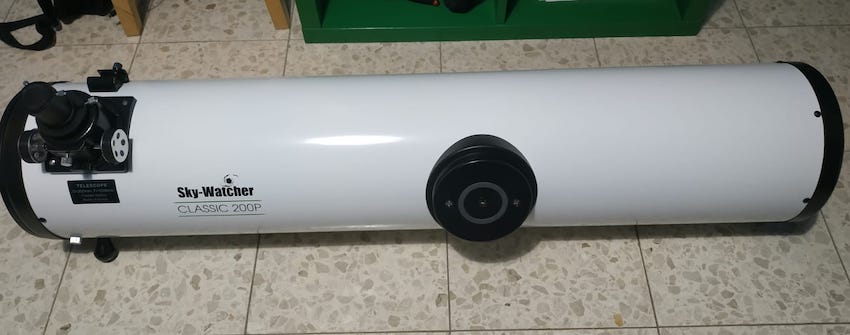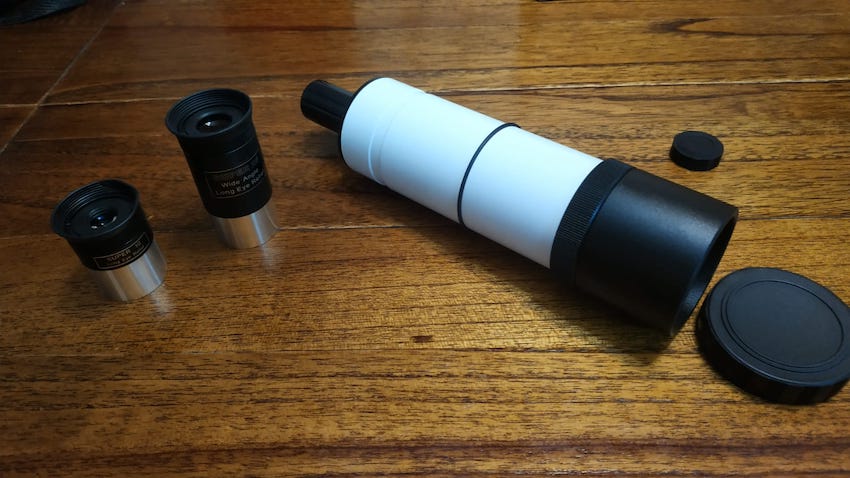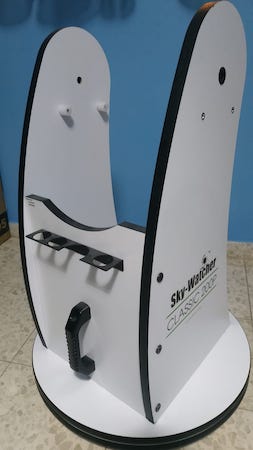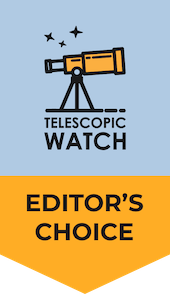The Optical Tube In 8″ Traditional

The 8” Traditional, or the Skywatcher Classic 200p, is an 8” f/5.9 Newtonian, manufactured by Suzhou Synta Optical Technologies—the same company that owns Celestron and manufactures Orion’s XT and XX Dobsonians. The mirrors are made of borosilicate glass (Pyrex), which expands far less with expansion and contraction than plate glass. Quality-wise, they tend to be good.
At f/5.9, there isn’t any coma like there is with faster scopes such as Sky-Watcher’s 10” and larger models, which have to have faster focal ratios to avoid being cumbersome and (at the largest sizes), requiring a tall ladder.
The 8” Traditional’s tube is identical in length to Sky-Watcher and other manufacturers’ 6” f/8 Dobsonians, and as a result, it is not really any more cumbersome to transport or more difficult to store.
RECOMMENDED BUY FOR THE WHOLE PACKAGE
I really like solid tubes for 8ʺ Dobs or larger. A 10ʺ scope becomes a bit uncomfortable to wrap your arms around, and a 12ʺ or larger is a nightmare to handle, unless you are built like Paul Bunyan.
The Focuser of Skywatcher Classic 200 Dobsonian
The focuser on the Skywatcher Skyliner 200P Classic Dobsonian is a rack-and-pinion. It works just as well as a Crayford unit, but there are two issues I have with it. First, the knobs are hard plastic with little ridges that dig into your fingers. Second, the focuser comes with a strange thread-on 1.25” adapter and a thread-on 2” adapter, which means that unless you spend additional money on a separate 1.25” to 2” adapter, you’ll be fumbling around in the dark with these silly adapters. I don’t get why Sky-Watcher elected to add this system rather than just supplying the 2” adapter and a 1.25” to 2” adapter.
Reviewing the Accessories

The 8” Traditional comes a 25mm (48x) and 10mm (120x) “Super” eyepieces that seem to be Plossls. They work well, but you’ll want some additional 6mm and 9mm “gold-line” eyepieces at the minimum for high power (the 10mm Super is a little short on eye relief), and a 2” wide-angle eyepiece to get the maximum possible field of view at low power for expansive views of nebulae, star clusters, and other deep-sky objects.
The 8” Traditional comes with a 9x50mm straight-through finderscope. In addition to being uncomfortable to aim through at almost every angle, the finder’s images are inverted. A Telrad is far easier to use, and a 50mm right-angle finder will also work well and do wonders for your neck.
About the Dobsonian Mount in Skywatcher Skyliner 200P Classic
Like all other Chinese-made Dobsonians, the Skywatcher Classic 200P Dob’s mount is made of melamine-covered particle board, which is basically sawdust compressed with glue and is a cheaper version of the stuff your IKEA furniture is sometimes made out of. It’s heavy compared to plywood, and if the melamine is damaged, even slight moisture (i.e., being used in the grass) will warp it.
Unlike Orion’s XT Dobsonians, which use springs for altitude tensioning and have the altitude bearings sit in cutouts in the mount, the Sky-Watcher Classic Dobsonians have the altitude bearings sit on brackets inside the rocker sides.
Altitude tensioning is provided by two handles which stick out from the rocker (basically bicycle grips). This system works well, but the handles can get caught on things such as loose clothing, especially in the dark.

The scope’s motions are pretty smooth, but the azimuth motion can be improved by replacing the cheap Nylon pads with real Teflon pads (available from various vendors on eBay and some hardware stores) and nailing a sheet of Formica onto the azimuth board. Due to the design of the altitude bearings, I would not recommend tampering with them.
The mount comes with a handle and an eyepiece tray—nice conveniences, but I don’t recommend using the latter as it’s a good way to get your eyepieces damaged/dewed up/dirty.
What All Can You See with SkyWatcher Classic 200P?
The Moon looks good in any scope, but an 8” is a good general size for lunar viewing – you have decent resolution, but the Moon isn’t blinding at sane magnifications. Clavius can show three or four dozen craterlets, provided there is good seeing and collimation.
Jupiter’s moons are nice disks with an 8” and show some amount of colour, particularly Io, which is a ruddy orange-yellow. Jupiter itself shows many festoons, cloud belts, and, of course, the Great Red Spot.
Saturn shows several bands—currently it has three major ones—as well as the Cassini Division in its rings and several moons. Saturn’s largest moon, Titan, is a gold colour, but it falls short of being a disk with anything less than perfect seeing conditions.
Uranus’ moons can hypothetically be glimpsed with an 8”, but I’ve never done it in practice. Neptune is a nice azure disk, and Triton can be seen with some effort.
Outside the solar system, 8” of aperture is enough to show you the entire Messier catalogue, though a few galaxies like M74 and M83 may be difficult to see if you suffer from light pollution. The famous Whirlpool Galaxy can just show a hint of spiral arms from a dark site, and its companion M51B/NGC 5195 is pretty easy to see. M81 and M82 in Ursa Major are quite interesting. In the spring, the Virgo Cluster becomes a bit crowded with galaxies, and in the autumn, several smaller galaxy clusters may show at least one or two bright members with some effort.
Globular star clusters with an 8” actually start to show resolution. M2, M3, M5, M13, M15, and M92 in particular tend to show a fair amount of stars sprinkled across with an 8”, while M4 may yield fantastic views if you don’t live too far north and don’t have much light pollution to the south of you. Even the dimmer Messier globulars like M10, M12, and M79 can show hints of resolution with practice.
Many planetary nebulae besides the Ring and Dumbbell are interesting to investigate with an 8” (particularly with a light pollution or oxygen-III filter), such as NGC 1535 in Eridanus and the Eskimo Nebula in Gemini in the winter, and the Blinking Planetary Nebula and NGC 7027 in Cygnus in the summer.
Alternative Recommendations
The Sky-Watcher Skyliner 200P Classic is not our top pick in its price range due to the single-speed Crayford focuser and the less-than-ideal design of the altitude bearings; however, it is still a great scope. For your convenience, here are some alternatives around and above its price range that you might want to consider:
Under £700
- The StellaLyra 8”/Zhumell Z8/Orion SkyLine 8 offers a significantly improved 2” dual-speed Crayford focuser with a compression ring, a more comfortable right-angle correct image 9×50 finder, a built-in cooling fan, slightly better bearings that can be adjusted for balance, and a 2” low-power, wide-angle 30mm eyepiece instead of a 1.25” 25mm Plossl or wide-angle design.
- The Explore Scientific 10” Hybrid Dobsonian offers more aperture, and thus more light-gathering and resolving power, than an 8” Dobsonian like the Classic or AD8, but requires a significant upfront investment in new accessories and some DIY modifications to perform well.
- The Ursa Major 8 is very similar to the 8” Classic but lacks the Classic’s extra eyepiece or 9×50 finder. However, the bearings are more well-designed and the Crayford focuser has a compression ring as well as not requiring an annoying extension tube to reach focus with most eyepieces.
- The Sky-Watcher Virtuoso GTi 150P is smaller than the 8” Classic but features an ultra-compact collapsible tube and full motorized GoTo and tracking along with the same excellent pair of 1.25” Super eyepieces. You can use it manually with or without the GoTo functionality, or purchase the cheaper Heritage 150P in lieu of the GTi, which is identical apart from the lack of electronics.
£700-£1000
- The StellaLyra 10”/Zhumell Z10/Orion SkyLine 10 offers more aperture than the 8” Classic with significantly more bang for your buck, not only in the form of the larger primary mirror diameter but also with a dual-speed focuser, cooling fan, 2” 30mm SuperView wide-angle eyepiece, right-angle 9×50 finder scope, and a laser collimator included.
- The Celestron StarSense Explorer 8” Dobsonian is similar in design to the 8” Classic but features a lightweight base, a better included 1.25” adapter, and Celestron’s award-winning StarSense Explorer technology to help with locating objects in the night sky such as star clusters, nebulae, and galaxies via your smartphone.
- The Sky-Watcher 8” FlexTube Dobsonian is essentially identical to the 8” Classic, apart from its collapsible tube which reduces its length when stored and transported. This is helpful if you have a small vehicle or very little storage space, but there are some disadvantages from the open tube (such as the need for a shroud to block out stray light) and no weight savings, plus the same drawbacks of the 8” Classic’s design and accessories.
Aftermarket Accessory Recommendations
To enable a full range of magnifications and field of view options with the Sky-Watcher Skyliner 200P Classic, acquiring a few additional eyepieces is essential. The provided pair of eyepieces are good enough for you to get started with the basics and the 120x of the 10mm is enough for decent planetary views; however, a wide range of magnifications is crucial for observing various types of celestial objects. At the low power end, 38mm OVL PanaView (32x magnification) or a similar inexpensive 2” super wide angle (SWA) eyepiece delivers the lowest magnification and almost the widest possible true field of view that the Skyliner 200P can achieve. For medium magnification between those of the provided 25mm and 10mm eyepieces, we recommend a 16mm Ultra Wide Angle (UWA) eyepiece (75x magnification), or, alternatively, the more affordable 15mm redline/goldline ocular (80x magnification) for the Skyliner 200P Classic.
While not strictly necessary, it might be a good idea to obtain a 9mm goldline/redline (133x magnification) eyepiece to replace the Skyliner 200P’s included 10mm ocular, as it offers significantly longer eye relief, a wider and more immersive apparent field, and superior interior blackening for enhanced contrast and less scatter on bright targets. A 2x Barlow lens coupled with a 9/10mm eyepiece, or a dedicated 4mm UWA or 4mm planetary eyepiece (300x), will provide the highest magnifications likely to be of considerable usefulness with the Skyliner 200P Classic, provided your atmospheric conditions permit it.
You may also want to replace the Skyliner 200P’s stock 1.25″ extension tube/adapter system and 2″ extension tubes with higher quality alternatives. A compression ring 1.25″ adapter with filter threads will enable the use of 2″ filters with your 1.25″ eyepieces and provide a secure, non-marring grip without worry of your eyepieces getting scratched or managing to fall out of the adapter; similarly, a 35mm threaded extension tube with a 2″ compression ring adapter will offer the same benefits for heavy and expensive 2” eyepieces. These upgraded adapters will also allow for more accurate collimation by properly squaring up a collimation tool with the telescope and focuser body. At this scope’s focal ratio of f/5.9, collimation tolerances are starting to get somewhat critical – a Cheshire collimation tool is a sound and fairly small investment and will make accurately collimating the Skyliner 200P Classic considerably easier.
Additionally, you might want to replace or supplement the stock 9×50 straight-through finder supplied with the Skyliner 200P Classic with a zero-power reflex sight finder, such as the Telrad or Explore Scientific ReflexSight. Either option is far more user-friendly than the 9×50 finderscope, offering a simple illuminated reticle against a window aimed at the sky, making it remarkably intuitive to use.
Lastly, a narrowband Ultra High Contrast (UHC)/OIII nebula filter can significantly enhance your views of nebulae, such as the Orion Nebula, when using almost any telescope, including the Skyliner 200P Classic. This filter also improves the visibility of planetary nebulae by reducing the brightness of surrounding stars, making it easier for you to locate them at low power. Furthermore, it provides enough contrast improvement to unveil previously invisible nebulae throughout the night sky, such as the Crab Nebula and Veil Nebula supernova remnants, when using the Skyliner 200P Classic under dark skies. A 2″ filter will screw onto an aftermarket threaded 1.25″ adapter, such as the one mentioned earlier, and consequently be compatible with either size eyepiece.



The skywatcher 8″ Dobsonian is called Traditional, Skyliner or Classic. Why? Is this exactly the same scope or are there differences?
They are just different nomenclatures for different markets. Same product.